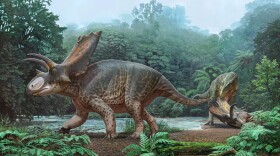A research team from the New Mexico Museum of Natural History & Science and the Smithsonian has discovered a new plant fossil that gives valuable insight into what southern New Mexico may have looked like in a time before dinosaurs roamed the earth.
KUNM’s Morning Edition host Bryce Dix sat down with the New Mexico Natural History Museum’s Paleontology Curator Spencer Lucas to learn more about the plant – which they named after a longtime volunteer at the museum.
SPENCER LUCAS: The name is Socorropteris cancellarei. It's a real mouthful.
It's a little plant. It's in sandstone, and you can tell that these sandstones represent what we call sheet floods. And what sheet floods are is when a river floods and it finally jumps its banks, the water will flow across the landscape in what we call a sheet flood, because it's no longer in a channel. Sheet floods are violent events. They're damaging to the landscape. We know that really well right now because of what happened in Texas just a couple of months ago. A lot of that was sheet flooding that caused all that death and destruction.
What happened is there was a sheet flood event, say, 290 million years ago that laid down a sandstone. Then on top of that sandstone are all the fossils of this little plant, and they're all knocked over and flattened by the next sheet flood.
What we think was going on is that this plant was able to colonize sheet-flooded sand surfaces, which are fairly unstable surfaces, and grow there until the next sheet flood. So, we see it as a rather opportunistic little plant that took advantage of violent, hydraulic or water-based events in its environment.
KUNM: 290 million years ago is hard for us to wrap our heads around. Can you paint us a picture of what southern New Mexico looked like back then?
LUCAS: Sure, back 290 million years ago, which is early in what we call the Permian period of Earth history, New Mexico was pretty much smack dab on the equator. All the continents had come together to form one supercontinent, and New Mexico was way out near the western edge of that supercontinent.
When you look at New Mexico more specifically, you could divide it into two environments. If you draw a line about east-west through Las Cruces, there was sea to the south of that. So, southern New Mexico, south of Las Cruces, was under seawater. Northern New Mexico was the area of what we call the ancestral Rocky Mountains. In those ancient mountain ranges, rivers were flowing from them into big flood basins in the lower territory.
This plant was living on those flood plains of the rivers that flowed from the ancestral Rockies, and ultimately, all those rivers flowed down to the shoreline near Las Cruces.
KUNM: There's a lot of discoveries of ancient dinosaurs and plant life going on here in New Mexico broadly, but also in Socorro County, where this plant particularly was found. Why is this such a hot spot of sorts for these kinds of discoveries?
LUCAS: Well, most of New Mexico I would describe as a high desert. And because of that, we have a lot of areas where rock, what we call bedrock, is exposed, and the fossils are going to be in that bedrock. And so this high desert called New Mexico is just loaded with fossils. And fortunately, the rocks with the fossils are not covered by soil or vegetation.
KUNM: Your team noted this discovery actually raised more questions than answers, especially about how rare this plant really was. So what's next? Are we likely to see more surprises in southern New Mexico in terms of ancient plant life?
LUCAS: Absolutely. The biggest question, and I alluded to this earlier, is we thought we understood what the flora — what the plants look like in New Mexico, in southern New Mexico, at this time, based on almost a century of work.
Now we see this rare plant in a rare environment. I think the next question is, how many other plants might there be? New plants, different, strange plants, living in other microenvironments. And that's something we want to search for. So basically you could say it changes the search image. Let's go out in the field and look at rocks that we didn't think plants would normally occur in, because we didn't think they could cut it in the environments those rocks represent. So that's a really big question: how diverse, how complex was the ancient flora of New Mexico 290 million years ago?





